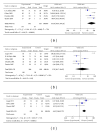Efficacy of intrauterine device in the treatment of intrauterine adhesions
- PMID: 25254212
- PMCID: PMC4165200
- DOI: 10.1155/2014/589296
Efficacy of intrauterine device in the treatment of intrauterine adhesions
Abstract
The primary purpose of this paper is to assess the efficacy of the use of the intrauterine device (IUD) as an adjunctive treatment modality, for intrauterine adhesions (IUAs). All eligible literatures were identified by electronic databases including PubMed, Scopus, and Web of Science. Additional relevant articles were identified from citations in these publications. There were 28 studies included for a systematic review. Of these, 5 studies were eligible for meta-analysis and 23 for qualitative assessment only. Twenty-eight studies related to the use of IUDs as ancillary treatment following adhesiolysis were identified. Of these studies, 25 studies at least one of the following methods were carried out as ancillary treatment: Foley catheter, hyaluronic acid gel, hormonal therapy, or amnion graft in addition to the IUD. There was one study that used IUD therapy as a single ancillary treatment. In 2 studies, no adjunctive therapy was used after adhesiolysis. There was a wide range of reported menstrual and fertility outcomes which were associated with the use of IUD combined with other ancillary treatments. At present, the IUD is beneficial in patients with IUA, regardless of stage of adhesions. However, IUD needs to be combined with other ancillary treatments to obtain maximal outcomes, in particular in patients with moderate to severe IUA.
Figures



Similar articles
-
Efficacy of estrogen therapy in patients with intrauterine adhesions: systematic review.J Minim Invasive Gynecol. 2014 Jan-Feb;21(1):44-54. doi: 10.1016/j.jmig.2013.07.018. Epub 2013 Aug 9. J Minim Invasive Gynecol. 2014. PMID: 23933351
-
Anti-adhesion therapy following operative hysteroscopy for treatment of female subfertility.Cochrane Database Syst Rev. 2017 Nov 27;11(11):CD011110. doi: 10.1002/14651858.CD011110.pub3. Cochrane Database Syst Rev. 2017. PMID: 29178172 Free PMC article.
-
Hormonally impregnated intrauterine systems (IUSs) versus other forms of reversible contraceptives as effective methods of preventing pregnancy.Cochrane Database Syst Rev. 2004;2004(3):CD001776. doi: 10.1002/14651858.CD001776.pub2. Cochrane Database Syst Rev. 2004. PMID: 15266453 Free PMC article.
-
Progesterone or progestogen-releasing intrauterine systems for heavy menstrual bleeding.Cochrane Database Syst Rev. 2015 Apr 30;(4):CD002126. doi: 10.1002/14651858.CD002126.pub3. Cochrane Database Syst Rev. 2015. Update in: Cochrane Database Syst Rev. 2020 Jun 12;6:CD002126. doi: 10.1002/14651858.CD002126.pub4. PMID: 25924648 Updated.
-
Interventions to prevent or treat heavy menstrual bleeding or pain associated with intrauterine-device use.Cochrane Database Syst Rev. 2022 Aug 26;8(8):CD006034. doi: 10.1002/14651858.CD006034.pub3. Cochrane Database Syst Rev. 2022. PMID: 36017945 Free PMC article.
Cited by
-
Clinical study on 2 types of intrauterine stents with different thickness and hardness in the treatment of moderate-to-severe intrauterine adhesions.Zhong Nan Da Xue Xue Bao Yi Xue Ban. 2022 Nov 28;47(11):1575-1585. doi: 10.11817/j.issn.1672-7347.2022.220340. Zhong Nan Da Xue Xue Bao Yi Xue Ban. 2022. PMID: 36481636 Free PMC article.
-
Extracorporeal Shock Wave Therapy Combined with Platelet-Rich Plasma during Preventive and Therapeutic Stages of Intrauterine Adhesion in a Rat Model.Biomedicines. 2022 Feb 17;10(2):476. doi: 10.3390/biomedicines10020476. Biomedicines. 2022. PMID: 35203684 Free PMC article.
-
In situ repair abilities of human umbilical cord-derived mesenchymal stem cells and autocrosslinked hyaluronic acid gel complex in rhesus monkeys with intrauterine adhesion.Sci Adv. 2020 May 22;6(21):eaba6357. doi: 10.1126/sciadv.aba6357. eCollection 2020 May. Sci Adv. 2020. PMID: 32494750 Free PMC article.
-
Effect of new biological patch in repairing intrauterine adhesion and improving clinical pregnancy outcome in infertile women: study protocol for a randomized controlled trial.Trials. 2022 Jun 18;23(1):510. doi: 10.1186/s13063-022-06428-0. Trials. 2022. PMID: 35717200 Free PMC article.
-
Treatment strategies for intrauterine adhesion: focus on the exosomes and hydrogels.Front Bioeng Biotechnol. 2023 Aug 31;11:1264006. doi: 10.3389/fbioe.2023.1264006. eCollection 2023. Front Bioeng Biotechnol. 2023. PMID: 37720318 Free PMC article. Review.
References
-
- Asherman JG. Traumatic intra-uterine adhesions. Journal of Obstetrics and Gynaecology of the British Empire. 1950;57(6):892–896. - PubMed
-
- Schenker JG, Margalioth EJ. Intrauterine adhesions: an updated appraisal. Fertility and Sterility. 1982;37(5):593–610. - PubMed
-
- Forssman L. Posttraumatic intrauterine synechiae and pregnancy. Obstetrics & Gynecology. 1965;26(5):710–713. - PubMed
-
- Louros NC, Danezis JM, Pontifix G. Use of intrauterine devices in the treatment of intrauterine adhesions. Fertility and Sterility. 1968;19(4):509–528. - PubMed
-
- Polishuk WZ, Anteby SO, Weinstein D. Puerperal endometritis and intrauterine adhesions. International Surgery. 1975;60(8):418–420. - PubMed
Publication types
MeSH terms
Substances
LinkOut - more resources
Full Text Sources
Other Literature Sources
Medical

